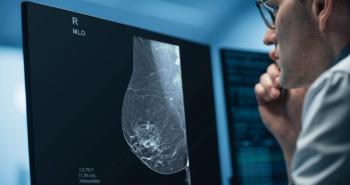
Screening Digital Mammo with Photon-Counting System Promising
Digital mammography with a photon-counting system had higher cancer detection rates than traditional systems.
Digital mammography with a photon-counting system provides high diagnostic performance for breast cancer, according to an article published in the journal Radiology.
Researchers from Germany undertook a retrospective study to analyze prospectively acquired data from mammography screening programs (DR photon-counting) of 13,312 women that took place in North Rhine-Westphalia and 993,822 women state-wide (37 computed radiography mammography systems and 55 DR systems). The photon-counting technique is a promising digital radiography (DR) approach that uses a unique detector to decrease scattered radiation and noise. The screenings took place between 2009 and 2010.
The researchers assessed diagnostic performance with cancer detection rate, recall rate, and proportion of small invasive cancers and ductal carcinoma in situ (DCIS). Mean glandular dose was calculated for DR photon counting and for a conventional DR subgroup. Differences were tested with x2 and t tests.
The findings showed that the DR photon-counting scan system had a cancer detection rate of 0.76 percent for subsequent screening, compared with 0.59 percent for the other screening units. The recall rate was 5.4 percent for the photon-counting method and 3.4 percent for the other methods.
“The higher cancer detection resulting from the use of the DR photon-counting scan system is due to high detection of both small, invasive cancers and ductal carcinoma in situ,” co-author Walter Heindel, MD, said in a release. Heindel is from the Department of Clinical Radiology at the University Hospital Muenster in Muenster.
The photon-counting technique had almost twice the detection rate of other methods for DCIS. It had a higher DCIS detection rate than the statewide units and the conventional DR subgroup.
In addition, the mean average glandular radiation dose of the DR photon-counting scan system was significantly lower than the conventional DR systems with the individually used parameters of the automatic exposure control.
The photon-counting technique also offers lateral dose modulation during the image acquisition, which can help account for differences in breast density. Cancer often is more difficult to detect in women with dense breasts.
“The innovative photon-counting technique offers further research potential,” Heindel said. “One future research direction is the application of spectral imaging for quantification of breast glandular tissue, addressing the problem of breast density.”
Newsletter
Stay at the forefront of radiology with the Diagnostic Imaging newsletter, delivering the latest news, clinical insights, and imaging advancements for today’s radiologists.




























